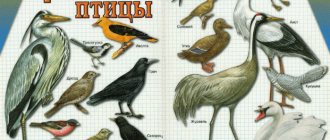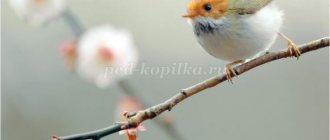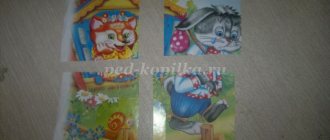Summary of the drawing lesson “How birds return from distant lands”
Milausha Gallyamova
Summary of the drawing lesson “How birds return from distant lands”
How birds return from distant lands
(examination of paintings by A.K. Savrasov
"The Rooks Have Arrived"
and A. A. Rylov
“Fresh Wind”
,
drawing )
Goals. Arouse in children interest in the topic of the image, an emotional response to it, a desire to reflect their impressions associated with poetic works and observations of the arrival of birds . birds returning from the south in a landscape , using the means of representation: drawing, color, composition, a low horizon line, arranging the format of a sheet of paper depending on the invented plot. Develop the ability to give emotional and aesthetic assessments and express detailed judgments.
Materials. Reproductions of art paintings by A. A. Rylov “Fresh Wind”
, A.K. Savrasova
“The Rooks Have Arrived”
, watercolor paints, brushes, palettes, album sheets of paper.
Schemes depicting birds in flight . Recording of the musical play “March.
Song of the Lark" from the cycle
"Seasons"
by P. I. Tchaikovsky.
Preparatory work. Observing spring changes in nature, the behavior of migratory and wintering birds . Reading works of fiction on the topic. Conversation about wintering and migratory birds . Looking at illustrations , drawings depicting different birds : rooks, starlings, swallows, larks, cranes, geese, swans, etc. Reading poems about spring, singing songs.
Class.
Educator. Children, you and I watched how all nature rejoiced in spring, waking up from sleep - trees, flowers, and people. But today we will talk about how birds . Remember, we saw how sparrows, pigeons, and crows bask in the warm rays of the sun, how they scurry around, bathe in puddles, chirp and croak loudly and joyfully.
The sun rises over the earth
Every day it gets higher
And all day long they circle and coo
Pigeons on the roof.
But spring is also a joy for birds that return from warm countries . Which birds returned first ? Yes, these are rooks. People say: “A rook in the yard means spring on the mountain.”
,
.
” Do you remember how we watched in the birch grove how the rooks rejoiced when they returned to their nests? Look at the painting “The Rooks Have Arrived”
by Alexei
Konstantinovich Savrasov . We have already looked at it. Tell me, what are these rooks doing? Where do they build their nests? What place did the artist paint ? What kind of weather is shown here? (Children's answers)
Not only rooks returned home, but also very interesting birds , they are called the first singers of spring. These birds imitate the voices of other birds and animals . Who is this? Yes, starlings. People say: “I saw a starling - it’s spring on the porch.”
.
We saw them too and even made a birdhouse for them. birds are also flying home . Yesterday we watched the cranes fly. How did they fly? A triangle, they say, “a jamb”
;
some birds fly in a caravan (one after another, others in flocks. Look at A. A. Rylov’s painting “Fresh Wind”
. Tell us, what kind of
birds are they flying ? How do they fly? What are they flying over? Have you noticed that the artist I painted them from a very close distance, they turned out large. What is the horizon line here? Why do you think the artist built the picture this way? (Children’s answers.)
On the topic: methodological developments, presentations and notes
Summary of a comprehensive lesson for children of the senior group, second period of study.
Lesson notes for the preparatory group on paper construction.
Summary of the lesson “The Arrival of Birds” on consolidating the lexical topic in the senior group of mental retardation (using mnemonics). Expanding and enriching the vocabulary on the topic; development of visual and auditory perception.
Scenario of a thematic lesson (circle “The Light of Orthodoxy”) Forty forties (bird arrival) Program objectives: - introduce children to the calendar.
Topic: “The arrival of birds.” Educational area: “Cognition,” “Artistic creativity.” Integrated educational areas: “Cognition,” “Communication,” “Physical education,” “Artistic creativity.”
This summary is intended to familiarize children with the characteristics of bird life in the spring and to instill in children a caring attitude towards birds.
In the first days of spring, you can watch the birds fly in the area with your children.
Summary of a drawing lesson for children of the younger group on the topic “Birds of Migratory”
Goal: Improve knowledge about migratory birds, learn to draw a starling, conveying characteristic features (color, shape, wings, tail).
1. Continue to introduce children to migratory birds.
2. To provide knowledge about adaptation to seasonal changes in nature.
3. Activate and enrich children’s vocabulary on the topic “Birds of Migratory”
4. Strengthen your ability to draw a bird, start with the shape of the head and body.
5. Learn to mix paints to find a new color (white + black = gray).
Material: pictures depicting migratory birds; drawing sheets, gouache, brushes, napkins.
Notes on drawing in the second junior group “Small Birds”
Tatyana Baybekova
Notes on drawing in the second junior group “Small Birds”
Age group : second youngest
Educational field: Artistic and aesthetic development – drawing
Theme in accordance with the comprehensive thematic plan: “Birds in spring”
Goal: To expand children's knowledge about birds.
Practice the technique of drawing with your palm , learn to convey the image of a bird in a drawing.
Develop fine motor skills of hands and fingers, teach how to draw in an unconventional way, develop imagination, creative skills, cognition, and communication abilities.
Enrich children's vocabulary and develop the ability to describe a bird using adjectives.
Cultivate a kind attitude towards birds.
To promote the manifestation of independence, confidence, and accuracy in working with paints.
Cultivate a feeling of joy in the result of your work.
Forms of organizing children's activities: frontal, individual
Forms of implementation of children's activities: conversation, outdoor play, drawing .
Types of children's activities: educational, playful, visual.
Equipment and materials: a toy bird (a birdhouse, paints (gouache, brushes, containers for paint, a container of water, paper towels, paper, plates for paint, a board for children’s work, musical accompaniment.
Looking at illustrations of birds.
Games with bird toys
Making and solving riddles.
Conversations about birds in spring.
D/game “Birds around us”
,
"Who lives where?"
P/game “Birds in nests”
,
"Homeless Bird"
.
GCD move:
The teacher calls the children to him and a recording sounds with the voices of different birds. The children listen carefully. Then the teacher asks the children to name what they heard.
the birds have flown to us . toy bird appears in the teacher’s hands ; together with the children, the teacher examines the toy and names the body parts).
All birds come to us in the spring from warm countries. So our bird flew to us from warm countries. She really wants to make friends with you and play with you. What do you want? (Yes)
Great!
Conversation about the bird :
Do you like the bird ? (Yes)
What bird ? (small, beautiful)
.
What can a bird ? (fly)
.
What does a bird have to fly? (wings)
.
What else can a bird ? (sing)
.
How does the bird ? (loudly, loudly, cheerfully)
.
Educator: Well done! And now, guys, I suggest playing with the bird .
Game " Birds in Nests "
The game is repeated 1-2 times at the request of the children.
Drawing birds:
Educator: Guys, I suggest you draw small birds with the help of your palms , they will sing and we will all have fun.
(Children complete the task, the teacher controls and helps)
Educator: Guys, while your drawings are drying, you come to me and we will wash your hands.
Using your imagination and imagination, see the silhouettes of birds in the handprints. Then the children add a beak , crest, scallop, paws, eyes and other elements to the image, if desired, and show their work to each other.
Progress of the lesson:
Educator: Guys, listen to the poem:
Spring has arrived in the snow,
Calling from all over
Geese, swifts and storks,
Cuckoos and starlings .
What time of year is the poem talking about? (Spring)
.
What is the most important sign of spring? Birds come to us in spring )
.
Where do they fly from? (From warm countries)
.
What are the names of birds that fly to warmer regions for the winter and fly back in the spring? ( Migratory )
.
What migratory birds do you know ? (Rook, starling , swallow, cuckoo, nightingale)
.
Guys, pay attention to the screen.
Educator: Guys, what kind of bird ? ( Starling )
That's right,
starling . Birds delight us not only with their appearance and the wonderful colors of their plumage , but also with their songs.
In the last lesson we drew a rook , and today I invite you to draw a starling .
Look at the sequence in which we will draw the starling .
Let’s before you start work. Finger gymnastics “ The birds are flying in ”
With the coming of spring,
The birds are coming.
We spread the fingers of both hands, connect the thumbs, and wave the rest like wings.
The starlings are returning ,
And we connect the rooks near the puddle-Palms together in a cup.
The cranes are flying in a hurry, - We spread the fingers of both hands, connect the thumbs, and wave the rest like wings.
And the robin and thrush,
Educator: Well done! Now, get to work.
These are the wonderful starlings we got !
Lesson notes for the senior group “Migratory Birds” Purpose. Formation of elementary ideas in children about migratory birds through active forms and methods of children’s activities. Tasks. Priority.
Summary of an integrated lesson on speech development in the senior group “Wintering and migratory birds” Synopsis of an integrated lesson on speech development in the senior group on the topic: “Wintering and migratory birds”. Goal: clarify and expand.






